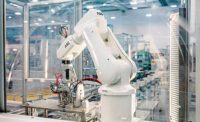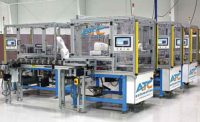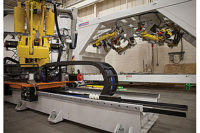Manufacturers looking to take their operations to the next level often look to automation and robotics to make it happen. This is understandable, for such technology can cost-effectively increase throughput, optimize assembly and testing processes, improve product quality and decrease labor costs.
In the case of industrial lead-acid battery manufacturer BBI Battery, management decided to replace a manually operated cast-on-strap (COS) machine with an automation-and-robotics-based workcell. A COS machine connects battery plates in multiple stages, using a rotating table with access to each process station.
MAC Engineering is one of the world’s most popular integrators of battery making equipment. Based in Benton Harbor, MI, it has supplied and installed more than 4,500 machines in 80 countries to date.
The workcell MAC developed for BBI provides the manufacturer with many benefits, including improved worker ergonomics. With BBI’s old COS machine, employees had to manually lift the battery plates and stack them into a plastic casing. Besides posing a high risk of injury, the process exposed workers to excessive airborne lead dust.
In the new approach, workers no longer need to lift the plates from the ground. Instead, they manually slide the plates onto a conveyor that aligns them and ensures they are even and flush.
From there, the robot picks up the plates and runs them over a large bristle brush to remove any lingering debris from the end connectors (called lugs). After the lugs are dipped into tin and then into molten lead, the robot places the plates into the casing.
BBI selected the ZX300S, made by Kawasaki Robotics U.S.A. Inc., because it can repeatedly lift and align 300 pounds of battery plates up to 1,000 times per day with high accuracy. This capability has enabled the manufacturer to increase production by 200 percent using less manpower.
The robot carries payloads of up to 300 kilograms, and has a high repeatability of ±0.3 millimeter. It also combines a long-reach arm with a minimal amount of dead space for a wide work envelope. These features proved ideal for BBI’s application, which required the robot to reach multiple machines at varying heights.
Two of Kawasaki’s other large payload robots, the B and CX series, offer repeatability of from ±0.06 to ±0.08 millimeter. Both series have a hollow arm structure, which allows for internal dressing of the robot. This feature simplifies installation by reducing the amount of time needed for digital engineering and building assembly lines, and minimizing the risk of interference with other robots or peripheral equipment.
As for BBI, its automated workcell has improved product quality and consistency over the last two years, while freeing up many workers to perform final assembly work on batteries. An average of five workers need to be present with the automated COS machine, compared with nine or 10 for the old manual machine.
For more information on six-axis robots, call 248-446-4100 or visit https://robotics.kawasaki.com/en1.





